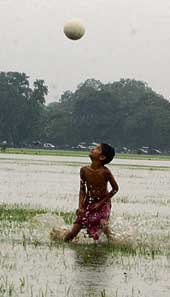 |
| On the Maidan, on a rainy Wednesday. Picture by Pradip Sanyal |
Indiscriminate filling up of waterbodies and wetlands in and around Calcutta is responsible for the waterlogging, feel environmentalists.
“Waterlogging in the city has worsened because of rapid filling-up of the East Calcutta Wetlands over the past few years,” said environmental activist Subhas Dutta, who referred the matter to the high court on Wednesday.
“Two large housing projects, a college, a number of industrial units and several buildings have come up on the wetlands, affecting its drainage and seepage capacity. The development of Rajarhat, which has eaten up large chunks of the wetlands, has also contributed to flooding,” said an environment department official.
“Because of encroachments, the East Calcutta Wetlands is losing its ability to drain out water,” said wetlands expert Dhrubojyoti Ghosh.
Another environmentalist pointed out that the development of Salt Lake and the “unplanned construction” of the EM Bypass have blocked the flow of rain water, resulting in widespread waterlogging.
The filling up of waterbodies within the city is also to blame. “On one hand, more and more buildings are coming up, reducing the amount of water that seeps through the ground, and on the other, the storm water retention capacity of the soil has gone down because of the filling up of ponds,” pointed out Mohit Roy, a green expert.
He feels that the encroachment of Bikramgarh jheel, off Anwar Shah Road, and the construction of a large housing estate in the vicinity are causing massive waterlogging in the Lake Gardens and Golf Club-Golf Green belt.
“In Behala, the flooding is due to the construction boom, mostly unplanned. Also, the area does not have a proper sewage system,” said a state pollution control board official.
A few years ago, the board had received a complaint that a estate was coming up in Behala, encroaching on Charial canal.











